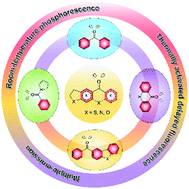Triplet harvesting aryl carbonyl-based luminescent materials: progress and prospective
Abstract
Triplet harvesting of organic materials is of great significance in many applications, including organic optoelectronic devices, anti-counterfeiting, and biological and chemical sensors. Aryl carbonyl-based luminescent materials have been widely studied in the above-mentioned fields because they possess intrinsic n–π* transitions as a result of the lone electron pairs of the carbonyl oxygen. Consequently, efficient intersystem crossing and reverse intersystem crossing can be achieved and triplet energy can be utilized through the narrow singlet–triplet offsets arose from the orthogonal overlaps between n and π* orbitals. It has also been revealed that they exhibit versatility in molecular tailoring and supramolecular engineering for various functional materials. This review presents a systematic summary of the recent research on aryl carbonyl (including moieties derived from aryl carbonyl) derivatives, with particular focus on their applications as electron acceptors, discussing the various strategies for the construction of luminescent materials with thermally activated delayed fluorescence and room-temperature phosphorescence, respectively. Finally, the perspectives and challenges concerning aryl carbonyl for triplet harvesting luminescent applications are also discussed.



 Please wait while we load your content...
Please wait while we load your content...